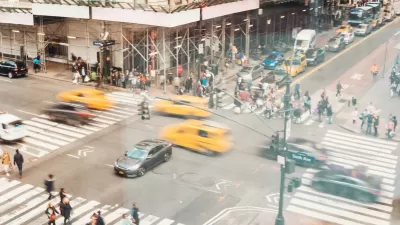Yesterday, Mayor de Blasio launched “Vision Zero”, a multi-agency effort to eliminate NYC's traffic deaths within a decade. With eleven deaths (seven of them pedestrians) already recorded in the new year, progress can't come soon enough.
With traffic deaths in New York City approaching falling homicide rates, Mayor Bill de Blasio is taking concrete steps to fulfill one of the most promising initiatives introduced during the mayoral campaign: “'Vision Zero' - a city with zero fatalities or serious injuries caused by car crashes on the streets of New York."
“'There is an epidemic of traffic fatalities and it can’t go on,' de Blasio said [at an event outlining the plan on Wednesday], noting that traffic fatalities are the leading cause of injury-related death for NYC children and that the city’s plunging homicide rate — 333 murders last year — is closing in on the number of traffic fatalities, which last year’s preliminary data puts at 286 people," reports Stephen Miller.
"In tone and substance, today’s announcement marked a notable departure from the days when NYC DOT was the sole city agency taking traffic violence seriously," he adds. "The interagency task force will convene over the next month before releasing a report with 'concrete plans' to carry out de Blasio’s Vision Zero campaign promises, namely: Dedicating more NYPD resources to traffic enforcement, improving design and enforcement along 50 dangerous corridors and intersections annually, expanding the number of 20 mph zones, and formulating a legislative agenda that includes securing home rule over traffic enforcement cameras."
FULL STORY: De Blasio Rolls Out a Multi-Agency Approach to Reducing Traffic Violence

Alabama: Trump Terminates Settlements for Black Communities Harmed By Raw Sewage
Trump deemed the landmark civil rights agreement “illegal DEI and environmental justice policy.”

Planetizen Federal Action Tracker
A weekly monitor of how Trump’s orders and actions are impacting planners and planning in America.

Why Should We Subsidize Public Transportation?
Many public transit agencies face financial stress due to rising costs, declining fare revenue, and declining subsidies. Transit advocates must provide a strong business case for increasing public transit funding.

Understanding Road Diets
An explainer from Momentum highlights the advantages of reducing vehicle lanes in favor of more bike, transit, and pedestrian infrastructure.

New California Law Regulates Warehouse Pollution
A new law tightens building and emissions regulations for large distribution warehouses to mitigate air pollution and traffic in surrounding communities.

Phoenix Announces Opening Date for Light Rail Extension
The South Central extension will connect South Phoenix to downtown and other major hubs starting on June 7.
Urban Design for Planners 1: Software Tools
This six-course series explores essential urban design concepts using open source software and equips planners with the tools they need to participate fully in the urban design process.
Planning for Universal Design
Learn the tools for implementing Universal Design in planning regulations.
Caltrans
Smith Gee Studio
Institute for Housing and Urban Development Studies (IHS)
City of Grandview
Harvard GSD Executive Education
Toledo-Lucas County Plan Commissions
Salt Lake City
NYU Wagner Graduate School of Public Service





























